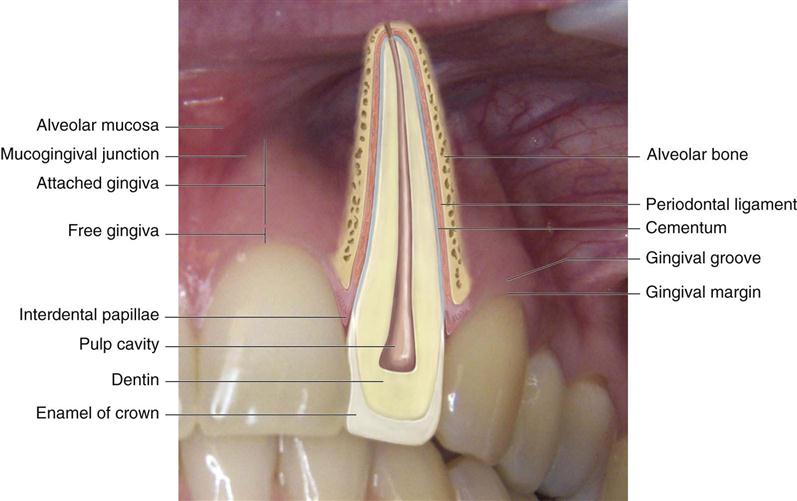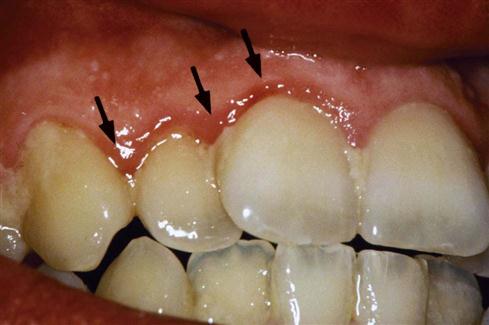Periodontal Disease
Learning Outcomes
On completion of this chapter, the student will be able to achieve the following objectives:
• Pronounce, define, and spell the Key Terms.
• Name and describe the tissues of the periodontium.
• Describe the prevalence of periodontal disease.
• Name the structures that make up the periodontium.
• Identify systemic factors that may influence periodontal disease.
• Identify and describe the two main types of periodontal disease.
• Explain the significance of plaque and calculus in periodontal disease.
• Identify the risk factors that contribute to periodontal disease.
• Describe the systemic conditions that are linked to periodontal disease.
Electronic Resources
![]() Additional information related to content in Chapter 14 can be found on the companion Evolve Web site.
Additional information related to content in Chapter 14 can be found on the companion Evolve Web site.
• Labeling Exercise: Anatomic Structures of a Tooth and Surrounding Area
• Labeling Exercise: Identify the Structures of the Periodontium
• Labeling Exercise: Identify the Periodontal Pocket and Strurtures
• WebLinks
Key Terms
Calculus (KAL-kyoo-lus) Calcium and phosphate salts in saliva that become mineralized and adhere to tooth surfaces.
Gingivitis (jin-ji-VYE-tis) Inflammation of the gingival tissue.
Periodontal (per-ee-oe-DON-tul) Referring to the periodontium.
Periodontitis (per-ee-oe-don-TYE-tis) Inflammatory disease of the supporting tissues of the teeth.
Periodontium (per-ee-oe-DON-shee-um) Structures that surround, support, and are attached to the teeth.
Perioscopy (per-ee-OS-kuh-pee) Procedure in which a dental endoscope is used subgingivally.
Plaque (plak) Soft deposit on teeth that consists of bacteria and bacterial by-products.
Subgingival (sub-JIN-ji-vul) Referring to the area below the gingiva.
Supragingival (soo-pruh-JIN-ji-vul) Referring to the area above the gingiva.
Periodontal disease is an infectious process that involves inflammation. Periodontal diseases involve the structures of the periodontium (Table 14-1).
TABLE 14-1
Structures of the Periodontium
| Name | Description |
| Gingivae | Commonly referred to as gums. This mucosa covers the alveolar process of the jaws and surrounds the necks of the teeth. |
| Epithelial attachment | Tissue at the base of the sulcus where the gingiva attaches to the tooth. |
| Sulcus | Space between the tooth and the free gingiva. |
| Periodontal ligaments | Dense connective fibers that connect the cementum covering the root of the tooth with the alveolar bone of the socket wall. |
| Cementum | Covers the root of the tooth. The primary function of the cementum is to anchor the tooth to the bony socket with attachments of the periodontal ligaments. |
| Alveolar bone | Bone that supports the tooth in its position within the jaw. The alveolar socket is the cavity in the bone that surrounds the tooth. |
From Robinson D, Bird D: Essentials of dental assisting, ed 4, St Louis, 2007, Saunders.
The periodontium is made up of structures that surround, support, and are attached to the teeth (Fig. 14-1). Periodontal disease causes a breakdown of the periodontium, resulting in loss of tissue attachment and destruction of alveolar bone.
This chapter discusses the various types of periodontal disease, including causes and common signs and symptoms. Chapter 55 discusses the dental specialty of periodontics, including periodontal charting, instrumentation, treatment procedures, and surgical techniques.
Prevalence
Periodontal diseases are the leading cause of tooth loss in adults. Almost 75 percent of American adults have some form of periodontal disease, and most are unaware of the condition. Almost all adults and many children have calculus on their teeth.
Fortunately, with early detection and treatment of periodontal disease, most people can keep their teeth for life.
Periodontal Disease and Systemic Health
Recent evidence indicates that the presence of chronic inflammatory periodontal disease may significantly affect health conditions such as coronary heart disease, stroke, or preterm birth. Chronic inflammation appears to do harm to the entire body.
Some systemic conditions enhance a patient’s susceptibility to periodontal disease; periodontal disease, in turn, may actually increase a patient’s susceptibility to some serious systemic conditions.
See Box 14-1.
Cardiovascular Disease
Individuals with periodontal disease have a greater incidence of coronary heart disease. This results in an increased occurrence of strokes and heart attacks. Individuals with severe periodontal disease have 3 times the risk for stroke and 3.6 times the risk for coronary heart disease when compared with individuals without periodontal disease. Studies show that oral bacteria can easily spread into the bloodstream, attach to fatty plaques in the coronary arteries, and contribute to clot formation and heart attacks.
Preterm Low Birth Weight
Preterm birth is defined as birth that follows a pregnancy that is shorter than 37 weeks; low birth weight is defined as less than 5.5 pounds. Preterm birth and low birth weight are the two most significant predictors of the health and survival of an infant. Other risk factors such as smoking, alcohol use, and drug use also contribute to preterm low-birth-weight (PLBW) infants. Women with severe periodontal disease have seven times the risk for PLBW babies compared with women with little or no periodontal disease. This association may be linked to particular biochemicals that are produced with periodontal disease, such as prostaglandin E2, which may create hormones that cause early uterine contraction and labor.
Respiratory Disease
Individuals with periodontal disease may be at increased risk for respiratory infection. It appears that bacteria that have colonized in the mouth may alter the respiratory epithelium, leaving it more susceptible to pneumonia. In addition, in patients who already have chronic bronchitis, emphysema, or chronic obstructive pulmonary disease, existing conditions may be aggravated by inhalation of bacteria from the mouth into the lungs. These bacteria multiply in the respiratory tract and cause infection.
Causes of Periodontal Disease
Dental Plaque
Plaque is a soft mass of bacterial deposits that covers tooth surfaces. When the plaque layer is thin, it is not visible, but it stains pink when a disclosing agent (erythrosine stain) is applied (staining plaque is discussed further in Chapter 15). If it is not removed, plaque will continue to build up and will appear as a sticky white material (Fig. 14-2).
Although plaque is the primary factor causing periodontal disease, type of bacteria, length of time bacteria are left undisturbed on the teeth, and patient response to bacteria are all critical factors in the risk for periodontal disease. Plaque cannot be removed si/>
Stay updated, free dental videos. Join our Telegram channel

VIDEdental - Online dental courses




